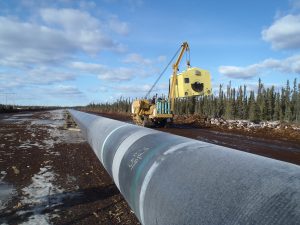The U.S. Court of Appeals for the Sixth Circuit has decided a new federalism case.  In State of Tennessee, et al., v. Federal Communications Commission, decided on August 10, 2016, the Court of Appeals held that Section 706 of the Telecommunications Act of 1996 does not authorize the Federal Communications Commission (FCC), acting as a federal agency, to preempt laws enacted by the legislatures of Tennessee and North Carolina to confine municipalities engaged in telecommunications services (by providing internet service) to their current territorial boundaries. This decision is important because it helps to define federal agencies’ authority to act.
In State of Tennessee, et al., v. Federal Communications Commission, decided on August 10, 2016, the Court of Appeals held that Section 706 of the Telecommunications Act of 1996 does not authorize the Federal Communications Commission (FCC), acting as a federal agency, to preempt laws enacted by the legislatures of Tennessee and North Carolina to confine municipalities engaged in telecommunications services (by providing internet service) to their current territorial boundaries. This decision is important because it helps to define federal agencies’ authority to act.
Articles Posted in Environmental
7th Circuit: DOE’s Use of Social Cost of Carbon Measure Okay
On August 8, the U.S. Court of Appeals for the Seventh Circuit, in a decision affirming the final energy efficiency regulations issued by the Department of Energy (DOE) for commercial refrigeration equipment, held that DOE’s use of a measure of carbon emissions known as the “Social Cost of Carbon” was proper under the law; that the Department was authorized to consider such environmental factors in its standards. The case is Zero Zone, Inc., et al., v. US Department of Energy.
Third Circuit Rejects Challenges to State Environmental Permits for Transco’s Pipeline Expansion Project
On August 8, the U.S. Court of Appeals for the Third Circuit released an opinion rejecting several challenges to  environmental permits and authorizations granted by environmental regulatory agencies in New Jersey and Pennsylvania. The consolidated cases are Delaware Riverkeeper Network, et al., v. Secretary Pennsylvania Department of Environmental Protection and New Jersey Conservation Foundation, et al, v. New Jersey Department of Environment of Environmental Protection, et al. At the outset, however, the Court of Appeals considered, and rejected, the arguments the states made that the Court of Appeals was without jurisdiction to review these petitions, particularly concerning those state actions assessing the water quality impacts of this pipeline expansion under Section 401 of the Clean Water Act (CWA).
environmental permits and authorizations granted by environmental regulatory agencies in New Jersey and Pennsylvania. The consolidated cases are Delaware Riverkeeper Network, et al., v. Secretary Pennsylvania Department of Environmental Protection and New Jersey Conservation Foundation, et al, v. New Jersey Department of Environment of Environmental Protection, et al. At the outset, however, the Court of Appeals considered, and rejected, the arguments the states made that the Court of Appeals was without jurisdiction to review these petitions, particularly concerning those state actions assessing the water quality impacts of this pipeline expansion under Section 401 of the Clean Water Act (CWA).
Recent Environmental and Administrative Law Decisions by Federal and State Courts
The state and federal appellate courts have issued a surprising number of significant rulings in a variety of environmental and administrative law controversies in late July and early August:
- On August 8, the U.S. Court of Appeals for the Second Circuit issued a very long (127 pages) ruling affirming in all respects the (400-page) opinion of the U.S. District Court for the Southern District of New York which found that a massive judgment obtained by the Ecuadorian plaintiffs against Chevron for alleged pollution in the Ecuadoran rain forest by Texaco many years ago was, in fact, procured by fraud. The case is Chevron Corporation v. Donzinger, et. al. The District Court enjoined Donzinger and his associates from seeking to enforce in the United States an $8.6 billion judgment; imposed a constructive trust for Chevron’s benefit on any property that Donzinger and his associates received that is traceable to this judgment or its enforcement; and held that the conduct of this litigation against Chevron violated the Racketeer Influenced and Corrupt Organizations Act, 18 U.S.C. §§ 1961-1968 (RICO) and also warranted relief under the common law of New York. The defendants-appellants argued that Chevron had no Article III standing to pursue this action, and that to uphold the judgment for Chevron would violate principles of international comity and judicial estoppel. This result confirms again the inestimable value of an independent, fearless judiciary, which is so sadly wanting in many areas of the world.
SCOTUS Round-up For 2015-2016 Term
Today, we published our alert Supreme Court’s Environmental and Administrative Law Decisions in 2015-2016 Term.  In the Advisory, we provide a brief report on some of the significant U.S. Supreme Court actions from January through June 2016 related to environmental and administrative law.
In the Advisory, we provide a brief report on some of the significant U.S. Supreme Court actions from January through June 2016 related to environmental and administrative law.
*Pillsbury summer clerk Brittney Sandler made significant contributions to this article. Sandler is currently enrolled at Georgetown University Law Center where she serves as editor for the Georgetown Law Journal and as a legal research and writing fellow.
Photo: Phil Roeder, Supreme Court of the United States, Taken March 15, 2011 – Creative Commons
DC Circuit Upholds EPA’s CAA Rules Governing Industrial Boilers and Incinerators
On July 29, 2016, the U.S. Court of Appeals for the DC Circuit released a very long (156 pages) opinion essentially upholding every regulatory decision made by the EPA in three major Clean Air Act (CAA) rulemakings: the “Major Boilers Rule”; the “Area Boilers” rule; and the “Commercial/Industrial Solid Waste Incinerators” (CISWI) rule. The consolidated cases are United States Sugar Corporation v. EPA; American Forest & Paper Association, et al. v. EPA; and American Chemistry Council v. EPA. These new rules , according to the Court, “set emissions limits on certain combustion machinery known to release hazardous air pollutants (HAPs),” and each rule was promulgated on March 21, 2011.
(156 pages) opinion essentially upholding every regulatory decision made by the EPA in three major Clean Air Act (CAA) rulemakings: the “Major Boilers Rule”; the “Area Boilers” rule; and the “Commercial/Industrial Solid Waste Incinerators” (CISWI) rule. The consolidated cases are United States Sugar Corporation v. EPA; American Forest & Paper Association, et al. v. EPA; and American Chemistry Council v. EPA. These new rules , according to the Court, “set emissions limits on certain combustion machinery known to release hazardous air pollutants (HAPs),” and each rule was promulgated on March 21, 2011.
CERCLA Lesson from Recent Ninth Circuit Decision
My colleagues Mark Elliott, Kevin Fong and I, in Lesson of Ninth Circuit CERCLA Decision: Prepare to Prove Recoverable Costs, discuss the lesson to be learned from the Ninth Circuit Court of Appeals’ June 13, 2016 decision in Whittaker Corp. v. United States. The Ninth Circuit held that a party which has settled its liability pursuant to a Comprehensive Environmental Response, Compensation, and Liability Act of 1980 (CERCLA) section 107 cost recovery claim may recover any response costs not covered by the settlement under CERCLA section 107. This decision confirms that a responsible party is not necessarily limited to a claim for CERCLA contribution under section 113 merely because it has been sued under section 107. Although Whittaker does not present a sea change for CERCLA claims, it serves as a reminder that documentation and segregation of costs sought in a CERCLA action are important to simplify recovery and to preserve recovery options
EPA Finds GHG from Aircraft Endanger Public Health
My colleague Matt Morrison today published a client alert titled U.S. EPA Finds Greenhouse Gas Emissions from Aircraft Endanger Public Health—a First Step in Adoption of New ICAO Standards. The Alert discusses the U.S. Environmental Protection Agency’s (EPA) issuance of a finding that aircraft greenhouse gas (GHG) emissions endanger public health and welfare in the wake of the International Civil Aviation Organization (ICAO) release of a draft rule in February of this year proposing a new standard for reducing GHG emissions in new and in-production commercial aircraft. The EPA’s finding is a prerequisite for new U.S. regulations setting standards for GHG emissions, which will be adopted after ICAO’s standard is finalized in March 2017.
U.S. EPA Finds Greenhouse Gas Emissions from Aircraft Endanger Public Health—a First Step in Adoption of New ICAO Standards. The Alert discusses the U.S. Environmental Protection Agency’s (EPA) issuance of a finding that aircraft greenhouse gas (GHG) emissions endanger public health and welfare in the wake of the International Civil Aviation Organization (ICAO) release of a draft rule in February of this year proposing a new standard for reducing GHG emissions in new and in-production commercial aircraft. The EPA’s finding is a prerequisite for new U.S. regulations setting standards for GHG emissions, which will be adopted after ICAO’s standard is finalized in March 2017.
Photo: Ikarasawa, JA67AN, Taken December 21, 2013 – Creative Commons
DC Court Confirms EPA May Reverse Its Position On Permit Issuance
In the latest installment in this long-running dispute, the U.S. Court of Appeals for the DC Circuit today, in Mingo Logan Coal Company v. EPA, ruled, in a 2 to 1 decision, that EPA satisfied its duties under the Clean Water Act (CWA) and Administrative Procedures Act (APA) when it vetoed a 404 dredge and fill permit Mingo Logan Coal Co. received from the U.S. Army Corps of Engineers (Corps) in 2007 with the concurrence of EPA, only to have EPA exercise its veto power in 2011. Mingo Logan also received a 402 permit from the State of West Virginia pursuant to its delegated authority. The dispute has been the subject of two district court rulings and now two DC Circuit Court of Appeals rulings.
DC Circuit Judge Rogers Delivers 3 Important Administrative Rulings in 1 Day
July 15 was a busy day at the U.S. Court of Appeals for the District of Columbia Circuit, as five important decisions were issued. What was remarkable and worth noting is that Judge Judith Rogers, a member of the court since 1994, was the author of unanimous opinions in three very important administrative cases:
issued. What was remarkable and worth noting is that Judge Judith Rogers, a member of the court since 1994, was the author of unanimous opinions in three very important administrative cases:
 Gravel2Gavel Construction & Real Estate Law Blog
Gravel2Gavel Construction & Real Estate Law Blog



